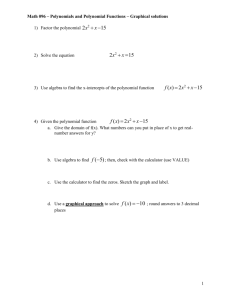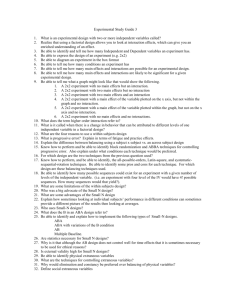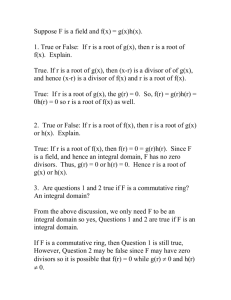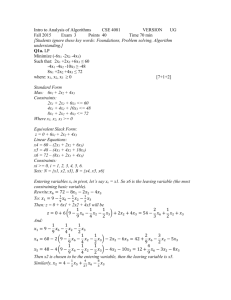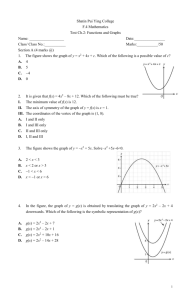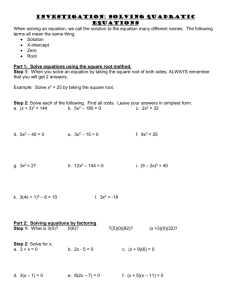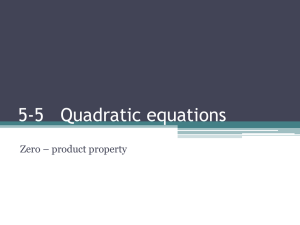question paper
advertisement
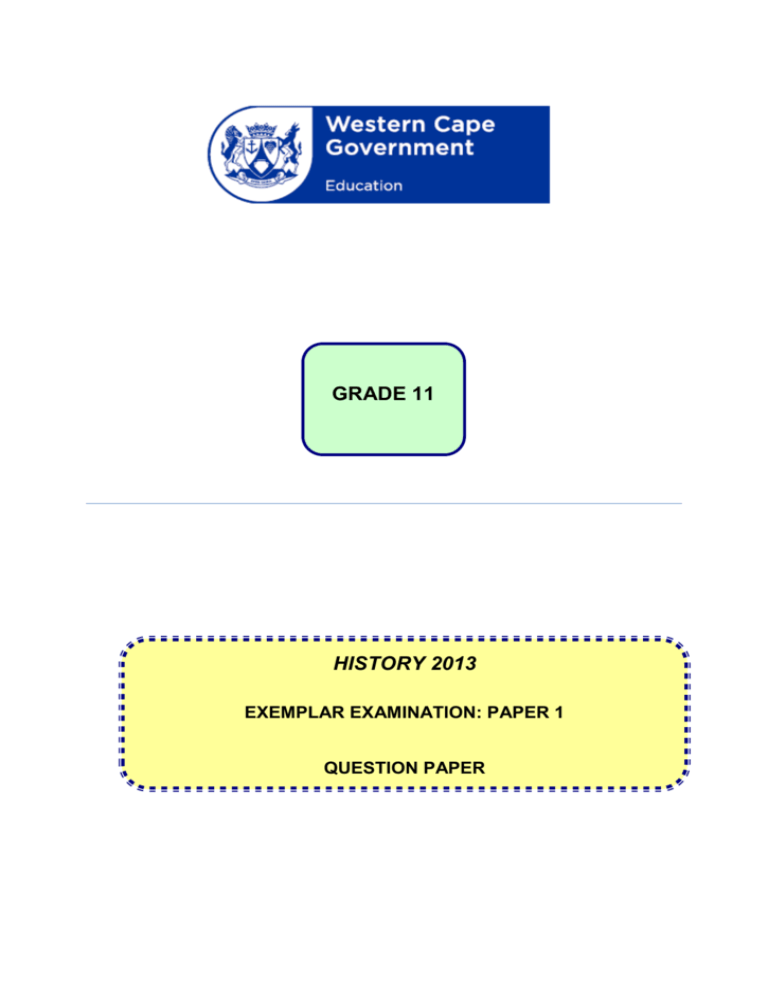
GRADE 11 GRADE 10 HISTORY 2013 EXEMPLAR EXAMINATION: PAPER 1 QUESTION PAPER GRADE 11: HISTORY - 2013 Paper 1 – Question Paper HISTORY PAPER 1 MARKS: 150 TIME: 3 HOURS Instructions and Information: 1. This question paper consists of SIX (6) questions which are as follows: SECTION A: SOURCE-BASED QUESTIONS QUESTIONS 1: COMMUNISM IN RUSSIA QUESTIONS 2: CAPITALISM IN THE USA 1900 TO 1940 QUESTIONS 3: IDEAS OF RACE IN THE LATE 19TH AND 20TH CENTURY SECTION B: ESSAY QUESTIONS QUESTION 4: COMMUNISM IN RUSSIA QUESTION 5: CAPITALISM IN THE USA 1900 TO 1940 QUESTION 6: IDEAS OF RACE IN THE LATE 19TH AND 20TH CENTURIES 2. Each question counts 50 marks. 3. Learners are required to answer any THREE (3) questions, ONE (1) sourcebased question, ONE (1) essay question and ONE (1) other, either an essay or a source-based question. 4. Learners may answer two questions on the same topic. 5. When answering of questions, learners are required to demonstrate application of knowledge, skills and insight. 6. Rewriting of sources in the answering of questions will be to the disadvantage of learners. 7. Source-based questions should be answered by referring to the ADDENDUM. 8. Learners are required to write neatly and legibly. 1 GRADE 11: HISTORY - 2013 Paper 1 – Question Paper SECTION A: SOURCE – BASED QUESTIONS QUESTION 1 DID THE PEOPLE OF RUSSIA BENEFIT FROM COMMUNISM UNDER LENIN’S RULE IN 1917 - 1924? Study Sources 1A, 1B, 1C, 1D and 1E and answer the following questions: 1.1 Refer to Source 1A. 1.1.1 What do you understand by the concept of a Revolution in the context of Source 1A? (3) 1.1.2 Which revolution is being referred to in Source 1A? (1x2) (2) 1.1.3 List the four causes that Lenin claims this revolution was being fought for. (4x1) (4) 1.1.4 Discuss whether this a reliable source to use for understanding the causes of the Communist Revolution in Russia in 1917? 1.2 (4) Refer to Source 1B. 1.2.1 Which group of people were, according to Source 1B, were regarded as the enemy of the revolution? (3x1) (3) 1.2.2 Why in your opinion did the young worker prefer that everyone should call each other ‘comrade’, instead of ‘Your Honour’ or ‘Master’? (2x2) (4) 1.2.3 Why would the people of Russia have felt more comfortable with armed workers patrolling the streets than ‘moustachioed policemen’? (2x2) (4) 1.2.4 What information in the source shows us that the young worker was passionate about his new status of ‘comrade’? (3x1) (3) 2 GRADE 11: HISTORY - 2013 Paper 1 – Question Paper 1.3 Refer to Sources 1C, 1D and 1E. 1.3.1 With reference to the figures in Source 1C, identify and explain the pattern of production and wages which can be seen during the periods 1913–1921 and 1921-1923. (2x3) (6) 1.3.2 How does the evidence in Source 1C help us to interpret and explain the photograph in Source 1D? (2x2) (4) 1.3.3 Extract evidence from Source 1E which shows that the economy started to recover with the introduction of the New Economic Policy. (3x1) (3) 1.3.4 Why does the author believe that ‘Communists’ would find the New Economic Policy ‘Repugnant’? (2x2) (4) 1.4 Use Sources 1A-1E and your knowledge to write a paragraph, of approximately 60-80 words, in which you contrast the expectations and the impact communist policies on the people of Soviet Russia between 1917 – 1924. (6) [50] 3 GRADE 11: HISTORY - 2013 Paper 1 – Question Paper QUESTION 2: WHAT OPINIONS DID AMERICAN PEOPLE HAVE OF THE NEW DEAL? Study Sources 2A, 2B, 2C, 2D, 2E and 2F to answer the following questions. 2.1 Study Sources 2A and 2B. 2.1.1 Extract three reasons from Source 2A which explain why Edward A. Filene supported the New Deal. (3x1) (3) 2.1.2 What information does Source 2A give to help us understand why some people in America were opposed to the New Deal? (2x2) (4) 2.1.3 What do you understand by the term Capitalism? (3) 2.1.4 What do you understand by the term Socialism? (3) 2.1.5 Look carefully at Source 2B. What is the artist’s opinion of the New Deal? Explain your answer fully by referring to the figure of Uncle Sam and the the ties which are binding him. (2x2) (4) 2.2 Study Sources 2B, 2C and 2D. 2.2.1 Identify and explain the views of the farmer in Source 2C towards the relief projects of the New Deal? (2x2) (4) 2.2.2 What does Source 2C suggest about the role of Eleanor Roosevelt, the President’s wife, during the New Deal? (3) 2.2.3 In what way does the cartoonist in Source 2B share similar concerns about the impact of the New Deal with the farmer who wrote the letter in Source 2C? (Identify the similarity and give an example from both sources to support your answer) (2x2) (4) 2.2.4 Langston Hughes, who wrote the poem in Source 2D, is also critical of the New Deal but presents a different set of reasons. Identify these reasons and substantiate your answer with reference to the source. (2x2) (4) 4 GRADE 11: HISTORY - 2013 Paper 1 – Question Paper 2.3 Refer to Source 2E. 2.3.1 Extract one piece of information from Source 2E and explain how it could have been used by a businessman (such as Edward A Filene) in support of the New Deal. (2x2) (4) 2.3.2 Extract one piece of information from Source 2E and explain how it could be used to respond to the poet Langston Hughes in 1934 (Source 2D) and support the work of the New Deal. (2x2) (4) 2.3.3 Evaluate the reliability of Source 2E. 2.4 (4) Refer to Sources 2A - 2E. 2.4.1 Use evidence from Sources 2A - 2F to write a paragraph of approximately 6080 words in which you discuss the different opinions held by Americans about Roosevelt’s New Deal. (6) [50] 5 GRADE 11: HISTORY - 2013 Paper 1 – Question Paper Question 3: HOW DID THEORIES OF RACE AND EUGENICS INFLUENCE GOVERNMENT POLICIES IN THE 19TH AND 20TH CENTURIES? Study Sources 3A, 3B, 3C, 3D, 3E, 3F and 3G to answer the following questions. 3.1 Refer to Source 3A. 3.1.1 What do you understand by the term pseudo-scientific racism? 3.1.2. Compare Linnaeus’s description of European people with that of African people in his Systema Naturae (Source 3A). Explain Using clear examples from the source, why this is an example of pseudo-scientific racism? 3.2 (3) (2x3) (6) Refer to Sources 3B and 3C. 3.2.1 Extract evidence from Source 3B to help explain how Europeans imperialists were able to use pseudo-scientific racism to justify colonisation in the 19th and early 20th centuries. (2x2) (4) 3.2.2 Contrast the way in which scientists understood ‘race’ in the 19th century (Source 3B) with how they understand ‘race’ in the 21st century (Source 3C). (2x3) (6) 3.2.3 Discuss the usefulness of Sources 3B and 3C to a historian researching the role that science has played in the history of race. 3.3 (4) Refer to Sources 3D and 3E. 3.3.1 With reference to Source 3D, explain what you understand by the term ‘Eugenics’. (3) 3.3.2 What information in Source 3D (Extracts A and B) explain why Galton believes that it is our ‘duty’ to apply eugenics. (3x2) (6) 3.3.3 With reference to Source 3E, list four things which eugenicists might use to try and influence and improve the fitness of the human race. (4x1) (4) 6 GRADE 11: HISTORY - 2013 Paper 1 – Question Paper 3.3.4 How has the artist in Source 3E visually represented the theory of eugenics which is described in Source 3D? Answer with specific reference to two different aspects of the picture in Source 3E. (2x2) (4) 3.4 Refer to Source 3F. 3.4.1 What did the Eugenics society of American want to achieve? Support your answer with evidence extracted from Source 3F. (2x2) (4) 3.5 With reference to Sources 3A-3G write a paragraph of approximately 60-80 words in which you explain how the policy being described in Source 3F was a consequence of pseudo-scientific theories of race and eugenics. (6) [50] 7 GRADE 11: HISTORY - 2013 Paper 1 – Question Paper SECTION B: ESSAY QUESTIONS QUESTION 4: COMMUNISM IN RUSSIA To what extent did Stalin’s Five Year Plan and purges lead to human rights abuses in Russia between 1928 – 1939? (50) QUESTION 5: CAPITALISM IN THE USA 1900 TO 1940 American society in the 1920s has been described as a time of ‘The Good, The Bad and The Ugly’. Critically evaluate the accuracy of this description with reference to the economic and social life in the USA during the 1920s. [50] QUESTION 6: IDEAS OF RACE IN THE LATE 19TH AND 20TH CENTURIES “Science doesn’t function in a moral vacuum … It requires critical participation of freethinking peoples.” * Critically discuss this statement with reference to the use of pseudo-scientific ideas to create a racial state in Nazi Germany. [50] *This statement made at the opening of a museum exhibition in 2006 which displayed the history of the eugenics movement – its theory and practice. 8

